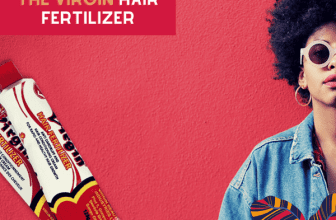
[ad_1]
 ”
”style=”;”
/>
Dry hair is the name of the game for many naturalistas. Due to the zig zag and coily shape of textured hair, the natural oils from the hair follicles in the scalp have a tough time travelling down the hair shaft; because of this, curly girls and more specifically, those with Type 3 and Type 4 hair, will usually find that their hair tends to dry out quickly, ends get brittle and prone to breakage, and curls frizz out and lose their shape.
But don’t despair! Co-washing could be just what your natural hair needs in order to strengthen the hair, retain moisture, and keep curls bouncy and full of life, without stripping the hair of its precious oils. Sounds too good to be true? Allow us to elaborate.
In this article, you’ll learn all about co-washing, its benefits, and how to co-wash your hair properly for the ultimate natural curls.
What is co washing?
Co-washing stands for Conditioner Only Washing. It basically means that instead of washing your hair with shampoo, you wash your hair with only a cleansing conditioner.For natural hair, this is a godsend.
Have you ever washed your hair only for it to feel more tangled than before? This is because, even the gentlest shampoos will have harsh cleansing agents that fight buildup and grease on the scalp. While this is great for those with oily hair, natural hair is already dry to begin with, and this dries the hair out even more, leading to dull hair, frizziness, and breakage. Some traditional shampoos even contain harsh sulfates (sodium laureth sulfate) and alcohols to aid in the cleansing process, which is detrimental to natural hair.
Co-Wash vs. Conditioner
Here’s the mistake many naturalistas make when they first try co-washing. They wash their hair with a regular conditioner. Although the name might be misleading, we don’t recommend using any old conditioner to co-wash; rather, look for a product that’s specifically labelled as a cleansing conditioner or co-wash.
Most conditioners are formulated to add moisture, detangle, and make curls soft, bouncy, and smooth. Since they’re usually meant to be used after a traditional cleansing shampoo, they don’t usually contain enough cleansing ingredients. This could lead to product buildup, and itchy scalp, greasiness, and general discomfort. If you’ve been trying to co-wash your hair and haven’t experienced any benefits, take a look at the co-wash product you’re using. This might be why.
Co-washes or cleansing conditioners, on the other hand, are specifically formulated to gently cleanse the hair with the added benefits of conditioner. They contain ingredients called cationic surfactants, which pick up small amounts of dirt on the scalp. This cleans the hair just enough, without completely stripping it. It’s a win-win for your healthiest hair!
Co-washing is also a great way to wash your curly clip-in hair extensions, which are already naturally dry as they don’t receive any natural oils from the scalp.
A note on natural oils
We talk about hair’s “natural oils” alot, but what exactly does that mean?
Sebaceous glands in our scalp produce an oil called sebum. Fun fact, this is the same oil that the pores on your face produce. Sebum helps waterproof and protect the hair and scalp from the outside world and maintain their health. Over time, a buildup of sebum on the scalp will lead to that greasy feeling. For those with thinner or straight hair, the sebum easily travels down the hair shaft, coating hair strands and keeping them healthy and hydrated. For those with curly or coarse hair types, the sebum has a more difficult time doing so. That’s why these natural oils are so important—when you constantly strip the scalp of the sebum, the hair gets drier and drier, not doing anyone any favours!
Benefits of co washing natural hair
1. Moisture retention
Ask any curly girl what the key to healthier looking hair is…the answer will usually be moisture! Shampoo is the most efficient way to remove greasy residue from the scalp. But it not only removes the bad grease, but the good grease too. Sebum is a substance in your hair that hair strands need in order to stay hydrated. Shampoo strips the hair of this oil, leaving already dry curls even drier. Co-wash, on the other hand, keeps the hair hydrated while gently cleansing the scalp of dirt and oils.
2. Prevents frizzy hair
You know that squeaky clean feeling you get after washing your hair with shampoo? That literally means that all your hair strands have been stripped of their oils. Without their natural oils, curls get brittle, dry, and frizzy. Because co-washing is so good at moisture retention, hair strands are more hydrated, reducing frizz.
3. Add shine and bounce
Is there anything worse than dull, lifeless curls? We may sound like a broken record, but again, this is due to dryness. Co-washing helps the hair retain its much-needed moisture, leading to healthier, bouncier curls, better curl definition, and shinier hair.
4. Helps with detangling
Detangling dry, damaged hair is a nightmare, especially if you have tight coils. When the hair is strong, healthy, and hydrated, detangling becomes all the more easier. Be sure to finger detangle once you’ve applied your co-wash or use a wide-tooth comb, detangling gently from bottom to top to undo knots and tangles.
How to choose the right co-washing product
Not all co-washes are created equal. When shopping for a co-wash, avoid ingredients with alcohols or sulfates, and those with silicones or proteins if you’ll be co-washing often.
Silicones are those ingredients that give your curls that incredible shine after washing; however, they aren’t water soluble, which means they tend to eventually cause build up and leave your hair worse off. Instead, find products with natural moisturizing ingredients to hydrate from the inside out. Aloe vera, honey, and shea butter are all good ingredients to look out for.
There’s also such a thing as protein overload. If you have high porosity hair, you’ll need extra protein to strengthen keratin bonds on your hair cuticle. Too much protein though, and your hair will feel gummy, straw-like, and lose elasticity.
Who should avoid co-washing
Although co-washing sounds like a miracle for natural hair, there are some drawbacks. Product buildup is a risk, as cleansing conditioners contain those cationic surfactants which don’t cleanse as thoroughly as regular shampoos. If you co-wash regularly, it’s a good idea to use a clarifying shampoo every now and again to thoroughly cleanse the hair and scalp before resuming your co-wash routine.
For those that suffer from conditions like psoriasis, seborrheic dermatitis or severe dandruff, co-washing is not recommended, as the cleansing ingredients are not strong enough to break down excess oils or flakes. Instead, opt for shampoos specifically formulated to address those concerns.
While co-washing is great for tight coils and curly hair, those with straight hair should avoid co-washing as it could weigh the hair down over time and lead to greasiness.
How to co wash
Let’s move on to our favourite co-wash method. Here’s how to do it:
Step 1: Thoroughly wet your curls once you step in the shower, making sure your hair is dripping wet. This will help distribute the product evenly as well as loosen up dirt on the scalp.
Step 2: Divide your hair into four sections to make it easier to properly cleanse all your hair.
Step 3. Squeeze out a healthy amount of conditioner. Don’t be shy! Remember, you’re not just conditioning, you’re cleansing as well, so you need a good amount of product to work through your hair.
Step 4. Start with one section, apply the product from root to tip. Scrub at your scalp using your fingertips to get rid of dirt and impurities.
Step 5. Use your fingers to detangle the section. Then comb through with a wide-tooth comb from bottom to top and twist the section.
Step 6. Repeat steps 3-5 for the rest of the sections. At this point, you can choose to leave the product in for 5-10 minutes like you would with a conditioner or hair mask, so your curls can drink up all the moisture.
Step 7. Rinse out your hair with water while your hair is still twisted. This will help retain your curls and make styling easier later. Make sure to focus on the scalp and be sure you wash off all the dirt and product.
Step 8. Use an old t-shirt or microfibre towel to dry your hair, gently squeezing out any excess water. Do not rub harshly with a regular towel as this will break up your curls and lead to frizz, tangling, and breakage.
Step 9. Apply your favourite finishing oil, or hydrating cream, and style as normal.
Step 10. As mentioned before, be sure to use a clarifying shampoo every so often to avoid product buildup.
Keep calm and co-wash on
And there you have it! A co-washing routine can be just what your natural hair needs to maintain hydration, restore your curl pattern, and reduce frizz and breakage. Try adding a co-wash to your wash days and let us know if you see the benefits in the comments below.
[ad_2]
Source link




